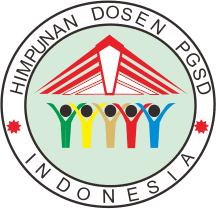Analisis prinsip praktis dari ing ngarsa sung tuladha pada pembelajaran kelas I sekolah dasar
Abstract
This study aims to examine the implementation of the Ing Ngarsa Sung Tuladha principle as part of the Among System in the learning process of Bahasa Indonesia in first grade at SD Negeri Soropadan. This principle is regarded as a pedagogical foundation that emphasizes the importance of teacher role modeling in shaping students' character and learning behavior, particularly in the early years of primary education. The research employed a qualitative approach using a case study method. Data collection techniques included observation, semi-structured interviews, and documentation. The data were analyzed using a descriptive-analytical approach through Miles and Huberman’s interactive model. The findings reveal that the teacher consistently applied the Ing Ngarsa Sung Tuladha principle across four key dimensions: attitude, behavior, action, and thought. The teacher served not only as a verbal and non-verbal role model but also fostered a learning environment that supports students’ independence, responsibility, and emotional development in a holistic manner. These findings highlight the significance of the teacher’s presence as a figure who internalizes and enacts the values of character education in daily teaching practice.
Keywords
References
J. P. Miller, The Holistic Curriculum, 2nd ed. Toronto: University of Toronto Press, 2007.
J. H. Pestalozzi, How Gertrude Teaches Her Children. 1801.
J. Dewey, Democracy and Education: An Introduction to the Philosophy of Education. New York: Macmillan, 1916.
B. S. Bloom, M. D. Englehart, E. J. Furst, W. H. Hill, and D. R. Krathwohl, Taxonomy of Educational Objectives, Handbook I: The Cognitive Domain. New York: David McKay, 1956.
J. Piaget, The Construction of Reality in the Child. New York: Basic Books, 1954.
E. B. Hurlock, Child Development, 6th ed. New York: McGraw-Hill, 1978.
A. Bandura, Social Foundations of Thought and Action: A Social Cognitive Theory. Englewood Cliffs, NJ: Prentice-Hall, 1986.
C. R. Rogers, Freedom to Learn: A View of What Education Might Become. Columbus, OH: Charles E. Merrill Publishing Company, 1969.
N. Chomsky, Aspects of the Theory of Syntax. Cambridge, MA: MIT Press, 1965.
K. S. Goodman, What's Whole in Whole Language? Portsmouth, NH: Heinemann, 1986.
D. P. Ausubel, Educational Psychology: A Cognitive View. New York: Holt, Rinehart and Winston, 1968.
Ki Hajar Dewantara, Bagian Pertama: Pendidikan. Yogyakarta: Majelis Luhur Persatuan Tamansiswa, 1977.
A. H. Maslow, Toward a Psychology of Being. New York: Van Nostrand Reinhold, 1968.
A. E. Martini, M. Matsuri, and R. Ardiansyah, “Analisis implementasi pendidikan seni tari berdasarkan teori pendidikan kesenian Ki Hadjar Dewantara di sekolah dasar,” Didaktika Dwija Indria, vol. 11, no. 4, pp. 37–41, 2023, doi: 10.20961/ddi.v11i4.77394.
Nugraha, Analisis Penerapan Pembelajaran Sejarah dengan Menggunakan Sistem Among di SMK Tamansiswa Nanggulan, Kulonprogo, Yogyakarta, Tesis, FKIP, Universitas Sebelas Maret, 2020.
D. P. D. Ramandhani and D. Widyartono, “Pendekatan kontekstual dalam pembelajaran bahasa Indonesia untuk membangun karakter melalui penerapan Sistem Among,” Journal of Language Literature and Arts, vol. 4, no. 12, pp. 1179–1188, 2024, doi: 10.17977/um064v4i122024p1179-1188.
A. F. Risqi, Rukayah, and S. B. Kurniawan, “Analisis kesulitan membaca permulaan dan faktor yang mempengaruhi pada peserta didik kelas I sekolah dasar,” Didaktika Dwija Indria, vol. 12, no. 4, pp. 252–257, 2024, doi: 10.20961/ddi.v12i4.85908.
A. Fitria, S. Istiyati, and F. P. Adi, “Penerapan model pembelajaran multiple intelligences untuk meningkatkan kreativitas berpendapat peserta didik dalam pembelajaran Bahasa Indonesia kelas 1 di sekolah dasar,” Didaktika Dwija Indria, vol. 12, no. 3, 2024, doi: 10.20961/ddi.v12i3.84451.
S. U. Harini, Sukarno, and S. Wahyuningsih, “Analisis dimensi proses kognitif pada soal formatif dalam buku Bahasa Indonesia Aku Bisa! kelas 1 sekolah dasar,” Didaktika Dwija Indria, vol. 11, no. 1, pp. 36–41, 2023, doi: 10.20961/ddi.v11i1.73413.
J. W. Creswell and C. N. Poth, Qualitative Inquiry and Research Design: Choosing Among Five Approaches, 4th ed. Thousand Oaks, CA: SAGE Publications, 2018.
R. C. Bogdan and S. K. Biklen, Qualitative Research for Education: An Introduction to Theories and Methods, 5th ed. Boston, MA: Allyn & Bacon, 2007.
M. Q. Patton, Qualitative Research & Evaluation Methods, 4th ed. Thousand Oaks, CA: SAGE Publications, 2015.
M. B. Miles, A. M. Huberman, and J. Saldaña, Qualitative Data Analysis: A Methods Sourcebook, 3rd ed. Thousand Oaks, CA: SAGE Publications, 2014.
E. L. Deci and R. M. Ryan, “The ‘what’ and ‘why’ of goal pursuits: Human needs and the self-determination of behavior,” Psychological Inquiry, vol. 11, no. 4, pp. 227–268, 2000.
E. B. Hurlock, Child Development, 6th ed. New York: McGraw-Hill, 1978.
N. Noddings, Caring: A Feminine Approach to Ethics and Moral Education, 2nd ed. Berkeley: University of California Press, 2003.
T. Lickona, Educating for Character: How Our Schools Can Teach Respect and Responsibility. New York: Bantam Books, 1991.
L. S. Vygotsky, Mind in Society: The Development of Higher Psychological Processes. Cambridge, MA: Harvard University Press, 1978.
Refbacks
- There are currently no refbacks.



